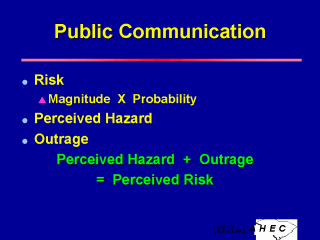| front |1 |2 |3 |4 |5 |6 |7 |8 |9 |10 |11 |12 |13 |14 |15 |16 |17 |18 |19 |20 |21 |22 |23 |24 |25 |26 |review |
 |
Understanding outrage is essential to communicate about risk. Risk in environmental health is formulated as magnitude (the size, severity, extent of area or population affected) x probability (how likely is the exposure or damage to occur). For example, an environmental risk assessment of a contaminated site calculate the dose that might be received through all routes of exposure, the toxicity of the chemical, the size and vulnerability (age, health) of the population potentially exposed (resident, future resident, transient) and the likelihood of exposure. This estimate of risk rarely correlates with the perceptions of the affected community and its individual members. That’s because community members are thinking of the risk in different terms. Peter Sandman developed through years of work in this area a different formula for risk. That is the one above: Perceived Risk = Perceived Hazard + Outrage. Dr. Peter Sandman, Rutgers faculty member, founded the Environmental Communication Research Program (ECRP) at Rutgers University, and created the “Hazard + Outrage” formula for risk communication. See web pages: qest.com.au/QestPeterSandman (for Peter Sandman) and aesop.rutgers.edu/cec (for Rutgers University, Center for Environmental Communication. |
| front |1 |2 |3 |4 |5 |6 |7 |8 |9 |10 |11 |12 |13 |14 |15 |16 |17 |18 |19 |20 |21 |22 |23 |24 |25 |26 |review |